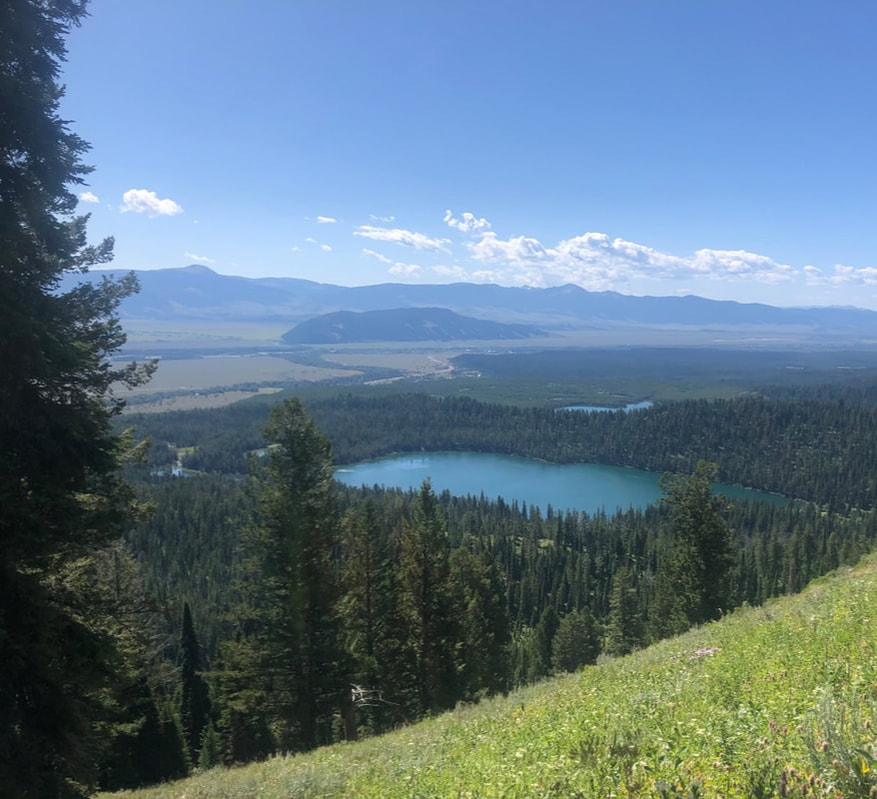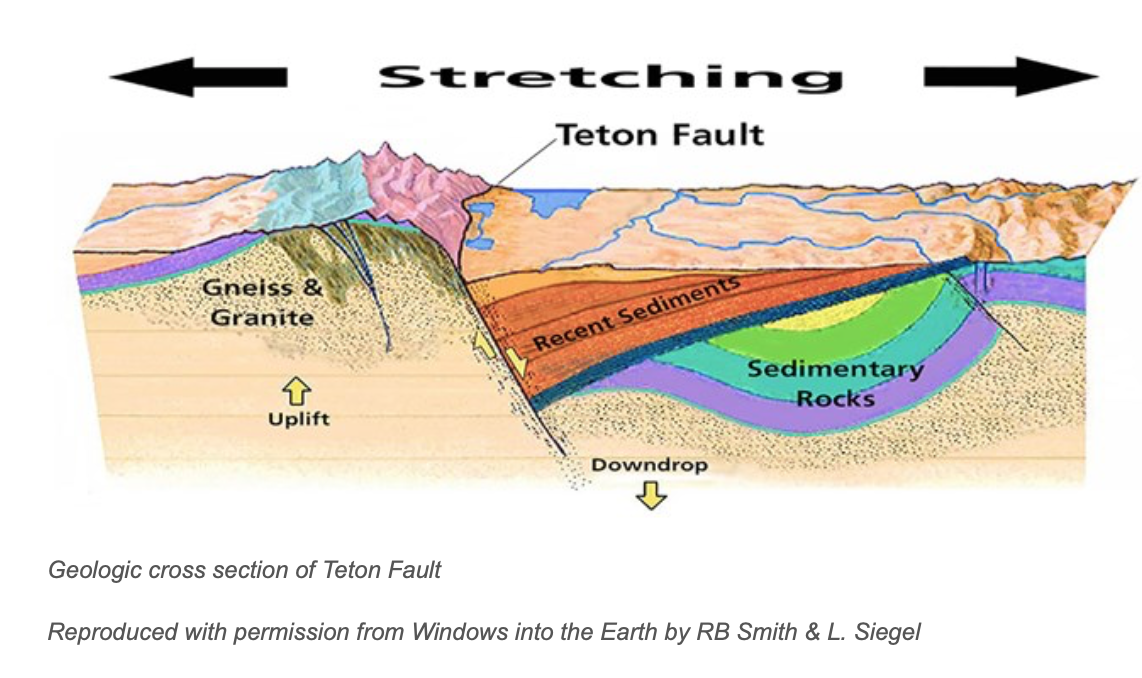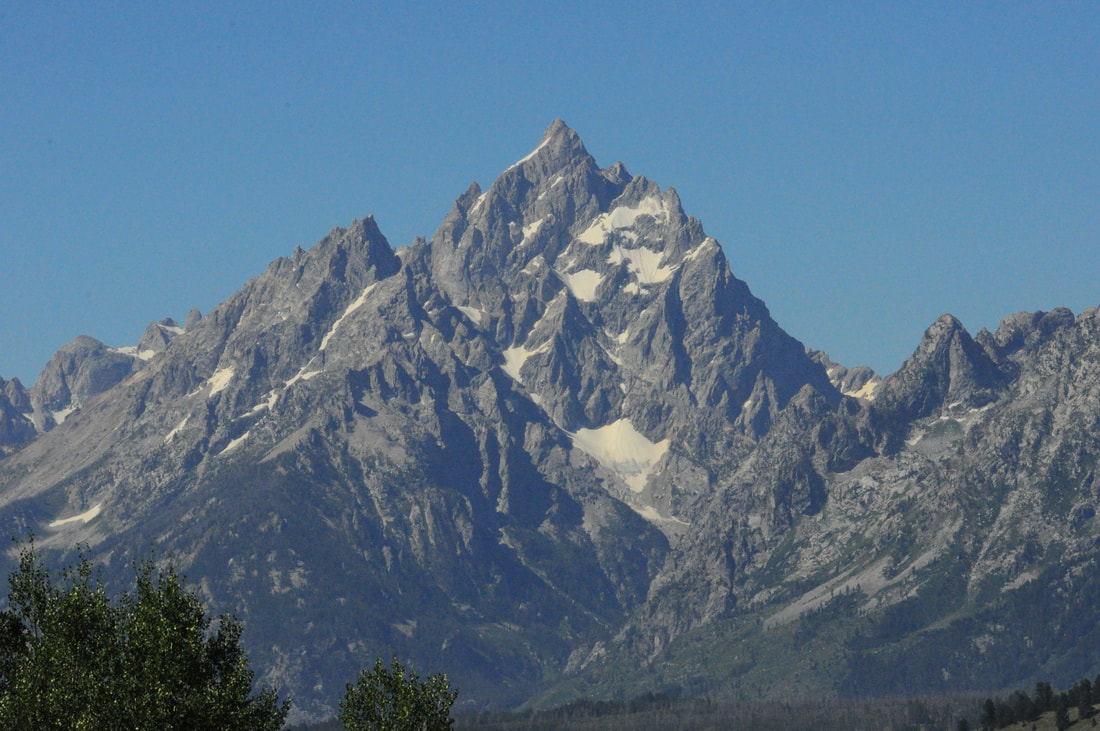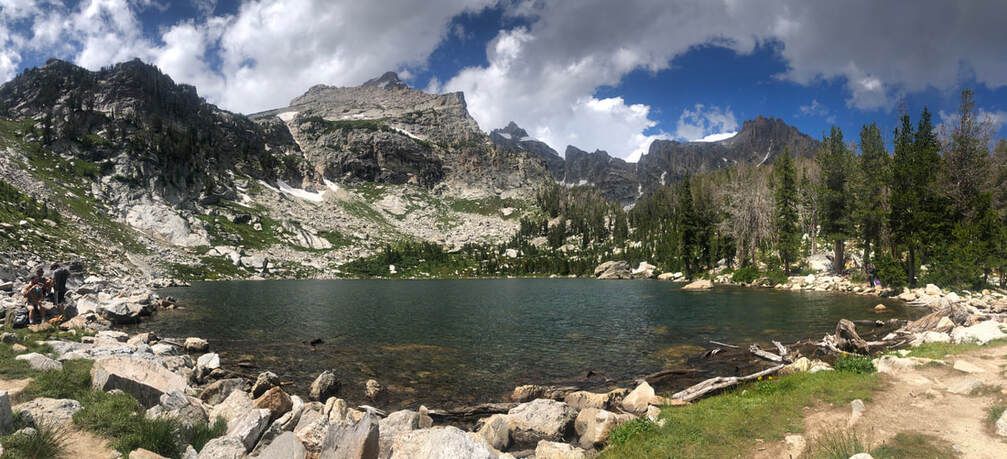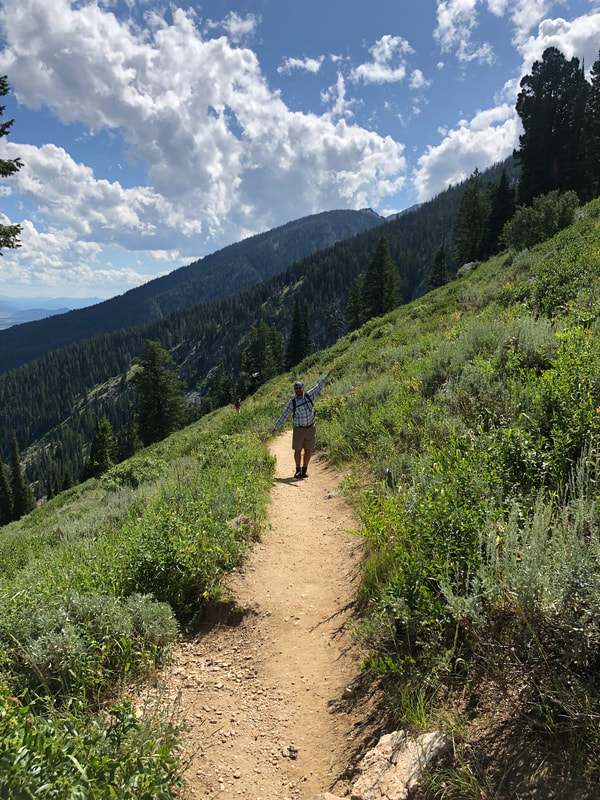Have you ever seen something so stunning, it’s hard to believe it was made by mother nature and not from a painting?
This is a photograph taken by me of the Grand Teton in 2020. In this picture you can see an entire ecosystem, it doesn’t look like much but what is really on the surface of the mountains? Glacial lakes, bears, berries and wildflowers are all on the surface of the mountain but none is viewable unless you’re on it too.
On the top of the mountains, you can see trees, glaciers and rocks living upon the massive face. Digging deeper into the mountain you realize it’s more than just a mountain, it’s a home for many animals and its telling a million years of history. You’re looking at hikers going on a journey to the top of the mountain, you’re looking at bears scouring for berries and chipmunks bugging humans for food. You’re looking at a place that has endured many ecological changes, including fires, the last ice age, a volcanic rupture. I Wonder what it had all looked like before the Teton range was formed.
This is a photograph taken by me of the Grand Teton in 2020. In this picture you can see an entire ecosystem, it doesn’t look like much but what is really on the surface of the mountains? Glacial lakes, bears, berries and wildflowers are all on the surface of the mountain but none is viewable unless you’re on it too.
On the top of the mountains, you can see trees, glaciers and rocks living upon the massive face. Digging deeper into the mountain you realize it’s more than just a mountain, it’s a home for many animals and its telling a million years of history. You’re looking at hikers going on a journey to the top of the mountain, you’re looking at bears scouring for berries and chipmunks bugging humans for food. You’re looking at a place that has endured many ecological changes, including fires, the last ice age, a volcanic rupture. I Wonder what it had all looked like before the Teton range was formed.
|
Grand Teton National Park is a popular attraction for backpackers, kayakers, animal sightings and back country hiking. The National Park is known for its outstanding scenery, its abundance of wildlife and the massive mountains known as the Teton Range. Many people haven’t experienced back country hiking and what can really be hidden in the mountains. Grand Teton got its name from Big South Butte and its’ two neighbors in Idaho which actually resemble breasts. They were originally known as Pilot Knobs by mountain men. Grand Teton is 310,000 acres in size and the highest peak is at 13,700 feet above sea level.
Grand Teton National park has a long history that dates back to 11,000 years but it was only established in 1929 and then again in 1950. Nomadic-Paleo Indians which are ancient Indians were the first people to come to the Tetons after the Pleistocene Ice Age glacier retreated. Due to the abundance of plant and animal wildlife, it was a great location for hunting and gathering. The only evidence that supports that the Indians were once present is tipi rings, fire pits and stone tools have been recovered from that era. Many tribes inhabited the area 8,000 to 1,500 years ago including Shoshone, Blackfoot, Gros Ventre and they lived off berries, roots and the game they hunted. |
|
In 1810, Fur trappers entered the valley which started the booming of fur trade. Fur trade drew many people from France, Germany, Scotland and many other countries. In 1872, the Tetons and Jackson Hole were mapped by Hayden Survey and this resulted in the first ascent of the Grand Tetons by the Hayden Expedition. In late 1880’s, people began to settle in the Teton area. In 1908, the Teton national Forest was established which encouraged more tourism. And in 1929 The Grand Teton National Park was established and reestablished with more land in 1950. In 1956, the first visitor center, which was the Colter Bay visitor center was opened and that created an influx of tourists. In 1988, one of the most destructive and largest wild fire burned through Yellowstone national park and Grand Teton National Park. Between 1990 to 2020 many more visitor centers were added, which increased tourism. There is also an airport in the national park but it was actually built before the reestablishment and came with the added land .A total of 158,112,167 people have toured the National park since it opened. In 1929 it only had 51,000 visitors and in 2019 it had 3,40,614 visitors.
|
With more visitors coming to the park, comes an impact on the environment. The Grand Teton National park deals with trampled vegetation, exotic non-native species accidentally introduced, the introduction of wildlife to human foods and human presence. If an exotic species is introduced and established in the ecosystem it can cause irreparable damage and alter the ecosystem’s function by displacing native plants and animals. Introducing the wildlife to human foods and our presence it can cause the animals to become unafraid of people which usually will lead to an animal/human conflict and cause for the animals to be euthanized. Additionally, wildlife is also frequently hit and killed by cars, due to distracted drivers and shocked animals. Due to the amount of visitors in the park, parking is sometimes hard to find so many people are parking the cars off the road which encroaches on the nearby vegetation. Many people will walk off marked trails into meadows which are very sensitive and will cause a trail to be made and can cause changes to the hydrology of the meadow. Many people feed or pet wildlife like deer and squirrels, this can be dangerous because animals may get violent, or it could disrupt the attitude and mood of their behavior. Many educational programs have been put in place to conserve the national park. The biggest threat to visitors in the national park is if a bear gets a hold of human food in a common area, that bear will revisit for food and potentially harm the visitors. |
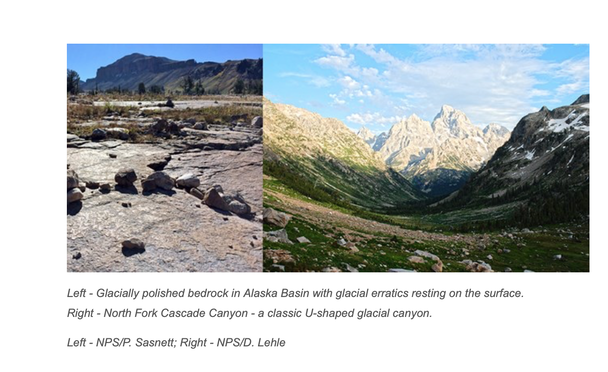
The Teton Range is 40 miles long and 9 miles wide and has 8 peaks over 12,000 feet in elevation, it is also one of the youngest range in the Rocky Mountains. But have some of the most ancient rocks in any U.S. National Park which are thought to be 2.7 billion years old. The Jackson Hole valley is 55 miles long, 13 miles wide and is 6,000 feet in elevation. The Tetons and Jackson hole goes back to 10 million years ago, it started forming when the crust of the earth was stretching and becoming more thin, and the forming of faults, which was causing earthquakes. The mountains sit on a Fault line, and The Teton fault slips which formed the Tetons and The Valley was formed by the Jackson Hole fault slipping and dropping off 20,000 feet. The Yellowstone Caldera ruptured 2 million years ago which caused lava to flow around both sides of the range. The volcanic ash from the rupture blew into the Tetons and valley which created a thick layer of ash almost a mile. The Tetons continued to build upward and the valley continued falling. The Tetons had glaciers more than 2,000 feet thick and Jackson Hole was covered in an Ice Sheet about 150,000 years ago. When the glaciers and ice sheet melted 80,000 years ago, it created a 16-mile 386-foot-deep depression known as Jackson Lake. It also created many glacial lakes, like Phelps and Jenny Lake and Amphitheater lake which is a cirque lake. There are currently 11 active glaciers in the park now, Obviously the creation of the lakes, was due to climate change and the glaciers melting. 25% of the total glacier cover has melted between 1967 and 2006. How long will these glaciers remain active in a fast changing climate?
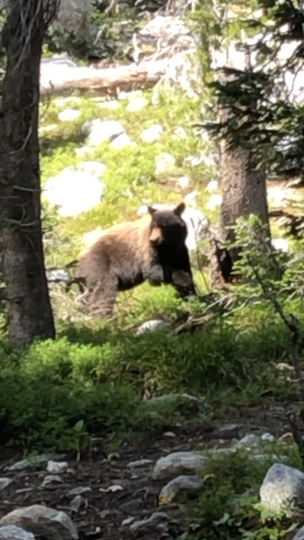 The bear we saw while walking back from our hike. zoomed in for better viewing
The bear we saw while walking back from our hike. zoomed in for better viewing
It was a cold start to the morning and we decided the plan for the day was to hike to Amphitheater lake, which is tucked into a stunning glacial cirque, which is just below the summit of Disappointment peak. Disappointment peak stands directly in front of the Grand Teton at 11,618 feet and they both initially appear as one peak. Disappointment peak is far from disappointing but it was named this because four climbers in 1925 set out to embark on the Grand Teton peak but found an impasse on the peak where a 450-foot drop is encountered between the two peaks and had a failed rappel attempt causing disappointment.
It was a strenuous 10-mile hike, with 5 miles of switchbacks up and down, if you don’t know what switchbacks are it’s essentially an easier way to climb up and down 3,000 feet. The hike starts at Lupine Meadow trailhead and starts off as a flat wooded path before you start making the incline. At about a half mile into the hike, we are at the base of the mountain, this is where the incline starts, it only starts at an 8% grade. At 1.2 miles in, this is where it really begins, the views are incredible, we can see the valley peeking through the trees.
We get to a junction where the trail breaks off to two different trail heads, we think we did the hard part, little did we know what was coming next. We headed straight to amphitheater lake. This trail is when the work really starts, we switchback up the entire face of the mountain. The switchbacks are 3 miles long at a grade of 20% and 2,300 feet of elevation gain to go before Amphitheater. Even though the switchbacks are the worst part of the entire hike, the views are immaculate. We can start to see over the trees and get a birds-eye view of Bradley and Taggart lake. As we climb up the mountain, we alternate between being in the forest to being on the exposed face of the mountain.
We are about two miles away from amphitheater lake, my legs are shaking, almost like my muscles can no longer stretch, I am out of breath and mentally struggling to continue walking. At this point, it’s pointless to turn back now, I’ve made it halfway, but yet I am crying, struggling to continue, I know it’s worth it so I push myself. One mile away now, I’m walking slowly as my body feels like it’s shutting down, trying to continue going up while other hikers are already going back down. We pass by a group of two adults who tell us that they sighted a bear up ahead. Now we are being cautious, bear spray in hand and talking very loudly. As we are walking up, we hear a crash in the woods, now this gets us freaked, my brother and dad pick up their speed, and here I am pushing myself to even continue walking at my slow pace. Would I rather get eaten by a bear or would I rather pick up my speed and see something so breathtaking? I went with the latter, we walked up the rest of the trail and the trees opened up into an amphitheater made out of rock.
The small glaciers sitting on the summit of disappointment peak, the peak itself, the relaxing breeze coming from around the mountains and the crisp and ice cold water of the lake is so clean, I could probably drink it. I have never seen anything quite as stunning as this. Although it was middle of summer it was quite cold, I had to put a jacket on. We take pictures, we eat our lunch while chipmunks try and bug us for food and we head back down. Now on our way back down, we end up running into a black bear, he is following the trail and is on our left, we are making sure to be loud so he knows we are there. We have our bear spray in hand, ready for anything that might occur. He sees us and ignores us and continues tearing open a rotten tree to eat out the bugs. It was quite scary, the national park service recommends to stay at least 100 yards away, this bear was probably 50 yards away, as he had just appeared right in front of us. This really makes me wonder how the wildlife feels about the tourism and people present here in Grand Teton National Park. Their homes are walked on by millions of people each year, have they become used to the people? How have humans affected the land and food access? Some bears here are rather aggressive with people and some bears show up at visitor centers with 100s of people around.
7 hours of constant hiking really pushes you to your limits. I had never been so happy to get back to a normal elevation, it was breathtaking to be up there but I needed to eat, and rest. While it mentally and physically challenged me beyond words, I would 100 percent do this hike again. No matter what you start doing in life, if you push yourself hard enough, you can achieve anything.
It was a strenuous 10-mile hike, with 5 miles of switchbacks up and down, if you don’t know what switchbacks are it’s essentially an easier way to climb up and down 3,000 feet. The hike starts at Lupine Meadow trailhead and starts off as a flat wooded path before you start making the incline. At about a half mile into the hike, we are at the base of the mountain, this is where the incline starts, it only starts at an 8% grade. At 1.2 miles in, this is where it really begins, the views are incredible, we can see the valley peeking through the trees.
We get to a junction where the trail breaks off to two different trail heads, we think we did the hard part, little did we know what was coming next. We headed straight to amphitheater lake. This trail is when the work really starts, we switchback up the entire face of the mountain. The switchbacks are 3 miles long at a grade of 20% and 2,300 feet of elevation gain to go before Amphitheater. Even though the switchbacks are the worst part of the entire hike, the views are immaculate. We can start to see over the trees and get a birds-eye view of Bradley and Taggart lake. As we climb up the mountain, we alternate between being in the forest to being on the exposed face of the mountain.
We are about two miles away from amphitheater lake, my legs are shaking, almost like my muscles can no longer stretch, I am out of breath and mentally struggling to continue walking. At this point, it’s pointless to turn back now, I’ve made it halfway, but yet I am crying, struggling to continue, I know it’s worth it so I push myself. One mile away now, I’m walking slowly as my body feels like it’s shutting down, trying to continue going up while other hikers are already going back down. We pass by a group of two adults who tell us that they sighted a bear up ahead. Now we are being cautious, bear spray in hand and talking very loudly. As we are walking up, we hear a crash in the woods, now this gets us freaked, my brother and dad pick up their speed, and here I am pushing myself to even continue walking at my slow pace. Would I rather get eaten by a bear or would I rather pick up my speed and see something so breathtaking? I went with the latter, we walked up the rest of the trail and the trees opened up into an amphitheater made out of rock.
The small glaciers sitting on the summit of disappointment peak, the peak itself, the relaxing breeze coming from around the mountains and the crisp and ice cold water of the lake is so clean, I could probably drink it. I have never seen anything quite as stunning as this. Although it was middle of summer it was quite cold, I had to put a jacket on. We take pictures, we eat our lunch while chipmunks try and bug us for food and we head back down. Now on our way back down, we end up running into a black bear, he is following the trail and is on our left, we are making sure to be loud so he knows we are there. We have our bear spray in hand, ready for anything that might occur. He sees us and ignores us and continues tearing open a rotten tree to eat out the bugs. It was quite scary, the national park service recommends to stay at least 100 yards away, this bear was probably 50 yards away, as he had just appeared right in front of us. This really makes me wonder how the wildlife feels about the tourism and people present here in Grand Teton National Park. Their homes are walked on by millions of people each year, have they become used to the people? How have humans affected the land and food access? Some bears here are rather aggressive with people and some bears show up at visitor centers with 100s of people around.
7 hours of constant hiking really pushes you to your limits. I had never been so happy to get back to a normal elevation, it was breathtaking to be up there but I needed to eat, and rest. While it mentally and physically challenged me beyond words, I would 100 percent do this hike again. No matter what you start doing in life, if you push yourself hard enough, you can achieve anything.
https://www.nps.gov/grte/learn/management/statistics.htm
https://irma.nps.gov/STATS/SSRSReports/Park%20Specific%20Reports/Annual%20Park%20Recreation%20Visitation%20(1904%20-%20Last%20Calendar%20Year)?Park=GRTE
https://www.frommers.com/destinations/grand-teton-national-park/a-nature-guide/landscape--geology
https://www.summitpost.org/page/153638
https://travelwyoming.com/article/human-history-grand-teton-national-park-and-where-find-it
https://www.nps.gov/grte/learn/historyculture/cultural.htm
http://www.ournationalparks.us/park_issues/visitors_to_parks_have_impact_on_ecosystems/
https://irma.nps.gov/STATS/SSRSReports/Park%20Specific%20Reports/Annual%20Park%20Recreation%20Visitation%20(1904%20-%20Last%20Calendar%20Year)?Park=GRTE
https://www.frommers.com/destinations/grand-teton-national-park/a-nature-guide/landscape--geology
https://www.summitpost.org/page/153638
https://travelwyoming.com/article/human-history-grand-teton-national-park-and-where-find-it
https://www.nps.gov/grte/learn/historyculture/cultural.htm
http://www.ournationalparks.us/park_issues/visitors_to_parks_have_impact_on_ecosystems/
